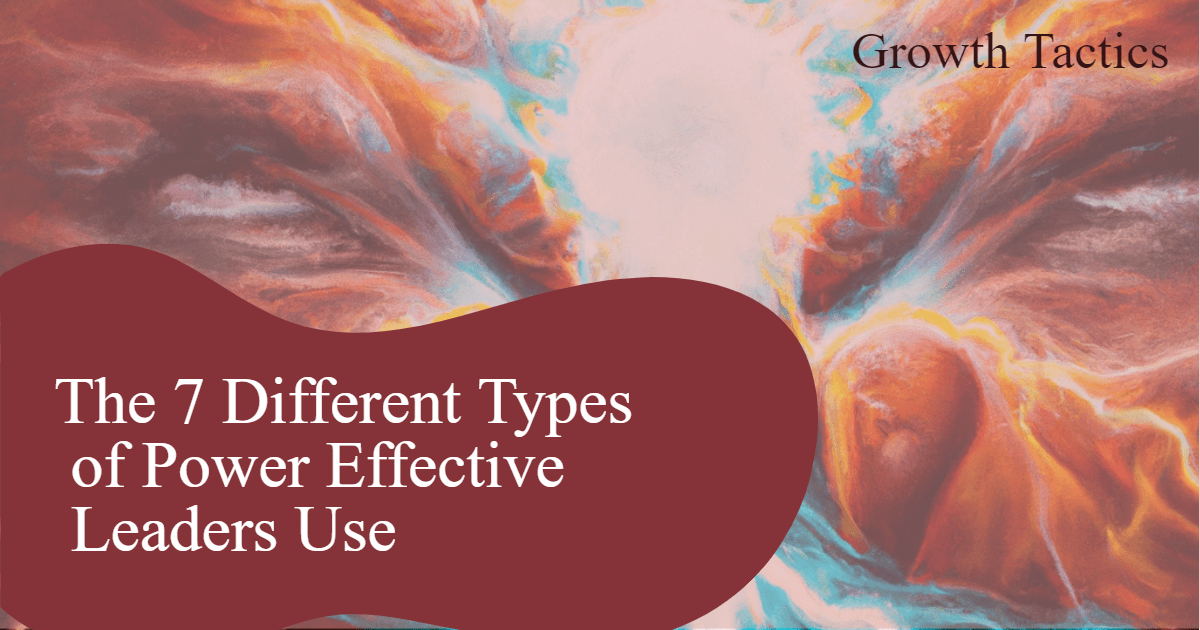Are you a leader looking for ways to make your mark?
Do you want to be a better leader?
Understanding the different types of power in leadership is key. Whether you’re aiming for influence in your business or beyond, having a firm grasp on position, personal, informational, referent, and expert power can help you reach your goals.
With the right knowledge and tools, you can leverage your power to influence people and situations. Both in and out of the workplace. Start leveraging your strengths today and become the leader you want to be.
Jump To Section
Where Does Power Come From?

Psychologists French and Bertram Raven identified different sources of power. The sources of power in leadership can be divided into seven categories: Legitimate Power, Reward Power, Coercive Power, Informational Power, Expert Power, Referent Power, and Charismatic Power.
Legitimate Power
Legitimate power in leadership is the power or authority given to a leader based on their position or title. It is the power that comes from a person’s position in an organization or hierarchy. It is usually derived from the formal authority granted to a leader by their job title.
Legitimate power can be used to influence others, but it is important to remember that it is not the only type of power that a leader can use. Other forms of power such as expert power, informational power, charismatic power, and referent power are also effective forms of personal power. Legitimate power should be used responsibly and with good leadership qualities, as it can be abused if not used correctly.
Steps to Build Legitimate Power
- Understand Your Role
Know the full scope of your responsibilities. Competence in your duties reinforces your authority. - Be Trustworthy and Reliable
Consistently deliver on your commitments. Reliability strengthens your position. - Cultivate Relationships
Invest time in understanding your team. Trust is mutual; empathy strengthens your legitimacy. - Communicate Clearly
Articulate your vision and decisions transparently. Clear communication builds accountability. - Maintain Ethical Standards
Lead with integrity. Ethical behavior ensures your power is respected, not feared. - Empower Your Team
Delegate responsibilities and encourage autonomy. Empowerment reinforces your leadership. - Stay Visible and Approachable
Be present and available. Your presence and approachability underpin your legitimate power.
Reward Power
Reward power in leadership is the power of a manager to confer rewards on employees to influence their behavior. Rewards can be either tangible, like a monetary bonus, or intangible, like employee recognition.
Reward power is a formal power given to a work leader to give out rewards to other employees. It is a power a leader has that allows them to give a reward to an employee as an incentive to improve, with two types of reward power being tangible and intangible.
Leveraging reward power effectively involves emphasizing the power of relationships and the power of information, and also developing their power to reward others. Organizations can use reward power to ensure the team is aware of the criteria that could lead them to receive the rewards and to increase competition among employees.
Steps to Build Reward Power
- Understand Team Motivations
Each individual is unique. Identify what drives each team member—financial incentives, recognition, or growth opportunities. - Set Clear Criteria
Clarify and communicate the criteria for rewards. Ensure they are challenging yet attainable, fostering transparency and fairness. - Balance Rewards
Use a mix of tangible (bonuses, gifts) and intangible rewards (recognition, praise) to address diverse motivations. - Leverage Information
Keep your team informed about their impact on organizational goals. When efforts align with bigger objectives, rewards are more meaningful. - Build Relationships
Cultivate trust and respect. Genuine relationships amplify the significance of rewards. - Consistency and Timing
Reward efforts promptly and consistently to build trust and morale. - Foster Healthy Competition
Encourage competition that promotes camaraderie and collective success, celebrating both individual and team achievements. - Adapt and Evolve
Regularly seek feedback to ensure rewards remain motivating. Adjust your system as needed.
Coercive Power
Coercive power is a form of authoritarian control that entails using force or threat of punishment to encourage individuals to act against their wishes to follow instructions or orders.
This power is the opposite of reward power, where rewards are used to encourage results instead of threats of punishment. It is distinct from personal power, which individuals can wield over themselves, and other forms of power people can’t use on themselves, such as referent power, reward power, and legitimate power.
Informational Power
Informational power is the capacity to influence others that is based on one’s knowledge of facts relevant to the situation. It is a form of personal or collective power that is based on controlling information needed by others in order to reach an important goal.
This is the newest addition to the types of power by French and Raven, and is in the top 3 most effective types of power. It is based on the idea that knowledge is power, and that timely and relevant information delivered on demand can be the most powerful tool for influence, decision-making, credibility, and control.
Steps to Build Informational Power
- Deepen Your Knowledge Base
Keep learning and stay ahead with industry trends and best practices. - Stay Updated
Regularly consume professional resources to remain informed. - Develop Critical Thinking
Analyze and synthesize information to discern valuable insights. - Control Information Flow
Share information strategically to influence outcomes. - Communicate Clearly
Articulate complex information simply and effectively. - Promote Knowledge Sharing
Foster a culture where information is shared openly to build trust. - Leverage Information
Use information to support your objectives and influence stakeholders. - Build Credibility
Establish yourself as an expert to enhance your influence.
Expert Power
Expert power is a type of personal power that is based on knowledge or expertise. It is the ability of an individual to influence others based on their expertise in a particular subject or situation. For example, if an employee has a deep understanding of a certain software program and no one else in the department knows how to use it, that employee has the expert power in that situation.
Expert power can be developed by working in a fast-paced environment and learning to make strategic, decisive choices quickly. This helps to develop excellent expert power and leadership skills. It is also important to diversify one’s skill sets in order to successfully complete projects.
Steps to Build Expert Power
- Continuous Learning
Stay committed to educating yourself. Continuous learning keeps you ahead in your field and sharpens your expertise. - Gain Hands-On Experience
Practical application of your knowledge in real-world situations solidifies your expertise. Don’t shy away from challenging projects—embrace them. - Work in Dynamic Environments
Fast-paced settings demand quick, strategic decisions. This hones your problem-solving skills and boosts your credibility. - Diversify Your Skill Sets
Broaden your expertise by learning adjacent skills. This makes you versatile and enhances your problem-solving toolkit. - Teach and Mentor
Share your knowledge with others. Teaching solidifies your mastery and establishes you as a thought leader. - Solicit Feedback
Seek constructive feedback from peers and mentors. This insight is invaluable for refining your expertise. - Attend Seminars and Workshops
Stay updated with industry trends by participating in professional development opportunities. Continuous exposure to new ideas fosters growth. - Leverage Your Network
Build a network of professionals in your field. Exchange insights and stay informed about the latest in your domain. - Document Your Knowledge
Write articles, papers, or blogs to share your insights. This helps you organize your thoughts and positions you as an authority.
Referent Power
Referent power is a type of power that stems from a leader’s ability to inspire and influence others. This authority comes from the extent to which people admire, respect, and like a specific leader. It relies on trust and democracy where a leader influences their followers (or in the workplace subordinates) through admiration and respect.
Steps to Build Referent Power
- Be Genuine
Authenticity inspires trust. Align your actions with your values to earn respect. - Develop Empathy
Understand and care for your team’s perspectives. Empathy fosters loyalty. - Lead by Example
Demonstrate the behavior you expect from others consistently. - Communicate Effectively
Maintain open, honest communication. Transparency builds trust. - Cultivate Emotional Intelligence
Manage your emotions and understand those of others. - Create a Vision
Share a compelling vision that resonates with your team’s values. - Show Appreciation
Recognize and celebrate contributions. Gratitude boosts morale. - Invest in Relationships
Build meaningful connections with your team. - Stay Humble
Acknowledge mistakes and welcome feedback. - Empower Others
Encourage initiative and leadership within your team.
Charismatic Power
Charismatic power is a type of power that is based on the personal charm and personality of an individual. It is the ability to influence others through the use of charisma, charm, and persuasion.
Charismatic power is often used in leadership roles, as it can help to inspire and motivate people to take action. It is also used in sales and marketing, as it can help to build relationships and trust with potential customers. Charismatic power is one of five types of power described in the bases of power. The other four types of power include reward power, coercive power, legitimate power, and expert power.
Steps to Build Charismatic Power
- Self-Awareness: Understand your strengths and limitations. Use them wisely.
- Effective Communication: Speak clearly and passionately to energize your audience.
- Confidence: Stand tall, maintain eye contact, and speak with conviction.
- Interest in Others: Listen actively and engage empathetically.
- Storytelling: Use powerful anecdotes to connect emotionally.
- Positivity: Encourage optimism and resilience in all situations.
- Authenticity: Be genuine in your interactions.
- Adaptability: Adjust your style to different contexts.
- Body Language: Use open gestures and maintain good posture.
- Personal Development: Continuously improve yourself.
How to Use the Different Types of Power
In order to use these different types of power effectively, leaders should focus on building relationships with their team members and understanding their individual needs. They should also be aware of the potential consequences of using each type of power and use them in a way that is beneficial to the team and organization.
When deciding which type of power to use, it is important to consider the situation and the desired outcome. For example, if a leader is looking to gain influence over their team, they may want to use legitimate power, which is obtained through demonstrating the skills required for the role. On the other hand, if a leader is looking to motivate their team, they may want to use reward power, which is the ability to offer rewards for desired behavior.
It is important to understand your own strengths and weaknesses when choosing the right type of power to use. Leaders should be aware of their own limitations and use the types of power that fit their skills and capabilities.
For example, if a leader is knowledgeable and experienced in a particular field, they may want to use expert power to influence their team. On the other hand, if a leader is more of a people person, they may want to use referent power to gain influence over their team Leaders should also be aware of their own emotional triggers and use the types of power that will not lead to negative consequences.
The Relationship Between Types of Power and Leadership Styles
Type of power can have a significant impact on a leader’s style. Coercive power, for example, is the power someone gains through threat or force. This type of power can lead to a leader being seen as authoritarian and controlling, which can be detrimental to morale and productivity.
On the other hand, referent power is the type of power that gives a leader the greatest influence. Leaders get referent power through qualities that inspire trust and respect in their colleagues. This type of power can lead to a leader being seen as a mentor and role model, which can be beneficial to morale and productivity.
Other types of power, such as the power of position, the power of charisma, and the power of relationships, can also affect a leader’s style. The power of position is the formal authority that derives from a person’s title or position in a group or an organization. Power of charisma is the influence that’s generated by a leader’s style or persona. The power of relationships is the influence that is generated by a leader’s ability to build strong relationships with their team.
Ultimately, the type of power a leader has can have a significant impact on their leadership style. It is important for leaders to be aware of the different types of power they have and to use them in a way that is beneficial to their team.
How to Increase Your Power
Leaders have the power to increase their influence and impact on their team in a variety of ways. Understanding the different types of power available to them is a critical first step.
According to Forbes, leaders can increase their power by becoming an expert in their field, developing their communication skills, building relationships with their colleagues, and understanding the power of their position.
Harvard Business Review suggests that leaders can strengthen their ability to influence people by building rapport with those they want to influence, making it clear that they value their colleagues’ opinions, and taking steps to demonstrate their credibility.
It’s also important to consider the potential consequences of using power incorrectly. Negative morale and reduced productivity are common results of coercive power, and a lack of trust and respect can result from an over-reliance on referent power. Leaders should strive to use their power in a way that is beneficial to their team and organization.
Did you enjoy this article on the 7 different types of power? Please share and subscribe below.








